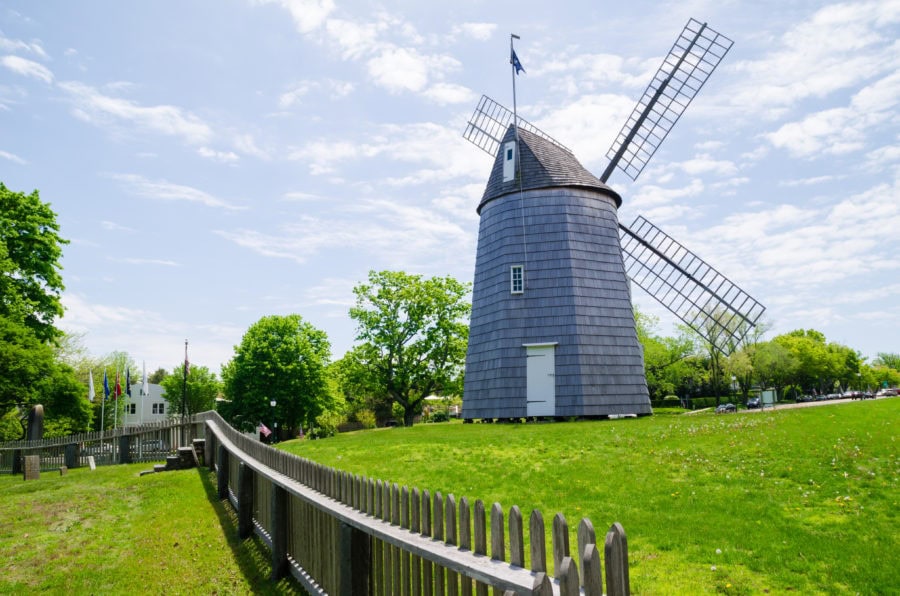
For some unexplainable reason, the Hamptons have perhaps the most concentrated array of windmills on the East Coast. There are eleven of them spread out from Stony Brook Southampton campus to Hook Windmill in East Hampton Village. Some of these windmills are located in their original locations while others have been moved. When they were moved, they were unassembled and reassembled. All 11 of the smock mill variety are similar to the ones in Europe and were built between 1760 and 1820. There are four windmills in East Hampton, more than any other town in the U.S.A.
They are originals except for the Sag Harbor windmill on Long Warf. This Windmill is a replica of one that was there. The present windmill was erected by the citizens of Sag Harbor in 1966 as a historic memorial to the whaling industry. The original was constructed in 1760 and actually stood 50 feet west of the now site. It’s a favorite Sag Harbor location for children to play, usually while eating ice cream.
Another windmill of distinction is the iconic Edward DeRose Windmill Cottage in East Hampton. It is a private residence and owned by Ironman himself, Robert Downey Jr., who actually married Susan Levin in East Hampton in 2005.
The Gardiner’s Island Windmill is not often seen close up by the general public unless they are boating in Gardiner’s Bay. It is also one of the oldest windmills still standing. This windmill was originally built in 1795 and is now located in the same place where the original Gardiners Island Lighthouse once stood.
The Old Hook Mill is a historic windmill on North Main Street in East Hampton and is more often referred to as the Hook Windmill. Reportedly built in 1806, it operated regularly for 102 years until 1908. It is perhaps the most complete of the existing windmills on Long Island.
The Pantigo Windmill is actually the third windmill built on Mill Hill on the south end of the historic common of East Hampton Village. The actual location of the Pantigo Windmill, called Mill Hill, was built up from a natural rise somewhere around 1729. A new windmill was built at that location in 1771, replacing a previous “post mill.”
The Beebe Windmill, located on the southeast corner of Ocean Road and Hildreth Avenue, was one of the first Long Island windmills to be equipped with a fly, regulators, and cast-iron gearing. It still has these original features. Of the famous 11, the Bebe has that honor. A unique feature of the Bebe is its ogee cap. Of all the Long Island windmills, only the Beebe has this decorative design. Due to these features, the Beebe is set apart from all the other East End windmills and is the only remaining Long Island windmill that is similar to the English windmills of the same period. It was in operation until 1915. Samuel Schellinger is credited for his work on both the Beebe Windmill and the Pantigo Windmill.
The windmill found on Stony Brook University’s Southampton campus may be the East End windmill that has had the most names. Now it is called the Southampton Windmill. However, in the past, it was known as the Mill Hill Windmill, the Clafin Windmill, and the College Windmill. It has a nice story because it was located originally on Hill Street in the Southampton Village. Then it was packed up and moved in 1890 to part of the Clafin estate (now SBU’s campus) back in 1890. For those who dwell on legends, this windmill is supposedly haunted by Beatrice Clafin. The story goes she played and died tragically in the windmill, breaking her neck after falling down the stairs.
The Corwith Windmill that everyone sees when they drive through Water Mill on Route 27 stands on a site that used to be home to another windmill. The original windmill there was reportedly destroyed in an 1811 blizzard. Two years later, in 1813, the destroyed windmill was replaced by a windmill originally built in 1800 in Hog Neck, North Haven. James Corwith purchased that windmill, supervised its being taken apart, and moved by “oxen” to Water Mill.
Another windmill that was moved is the Hayground Windmill that was moved from Hayground, Bridgehampton in the 1950s to Windmill Lane between Egypt Beach and Two-Mile Hollow Beach. Originally constructed in 1801. According to Anne Francis Leeds, “It was also reportedly the busiest, turning out more bushels than nearby windmills. Open seasonally, it operated 4 months of the year, turning out in 1870, 800 bushels of wheat, 800 of oats and 400 of corn.”
The Wainscott Windmill is located in the Georgica Association in the Wainscott neighborhood of East Hampton. According to a U.S. Department of the Interior report, “…this windmill was originally built on Mill Kill in Southampton in 1813” to replace a mill which had burned down the year before. “Mill Hill, which was also the site of other windmills, is now bounded by Windmill Lane and Hill Streets in Southampton Village.” With an incredible history, “ Lathrop Brown purchased the mill in 1922 and moved it to Montauk where it became part of a cottage he was building on the cliffs just west of the lighthouse… When the windmill was moved back to Wainscott in 1943, the mill tower was transported in four sections.” Moving forward when you next gaze at an East End windmill, know for sure you are looking at a primary artifact of Hamptons history.






